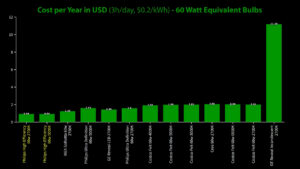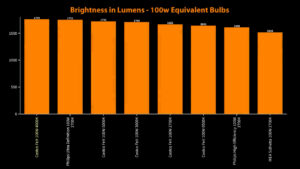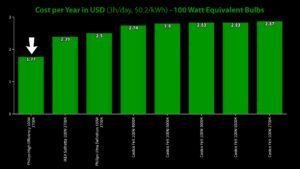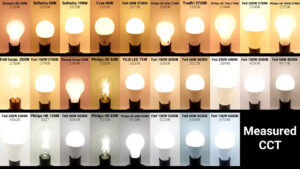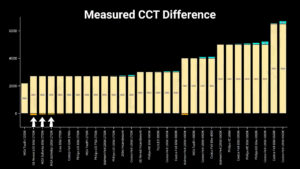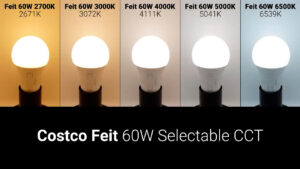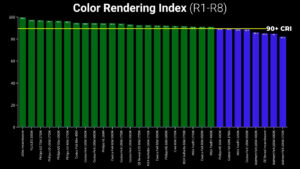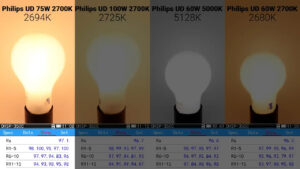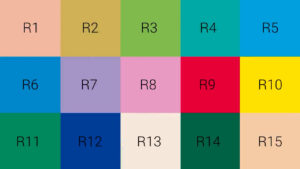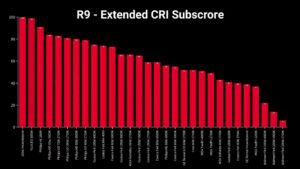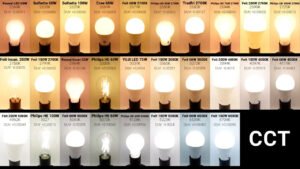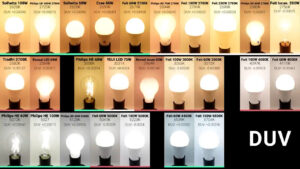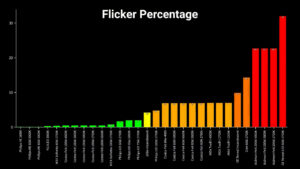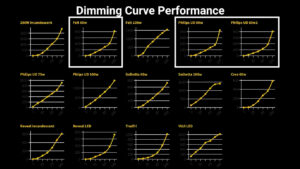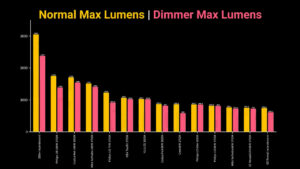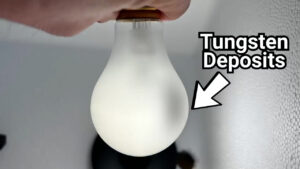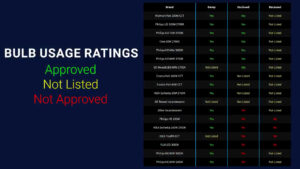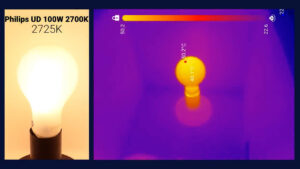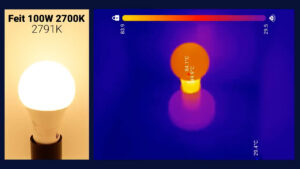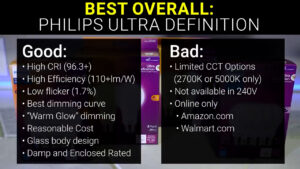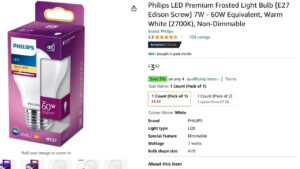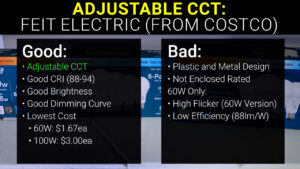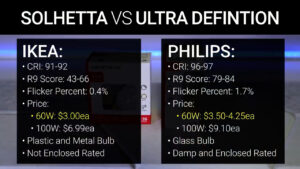Testing your most REQUESTED Lightbulbs from IKEA, Costco, Walmart, and Amazon
March 12, 2024Back in June I tested 25 of the best-selling LED lightbulbs on Amazon, and one bulb, the Philips 60W Ultra Definition came out on top in basically every measurement, but lots of people were disappointed that I didn’t test their favorite bulbs from IKEA, Costco, Home Depot, and Walmart, and other people said they wanted cooler color temperatures or higher brightness. So, in an attempt to please everyone, I ventured out of the house and into real stores, and I even signed up for a Costco membership just to buy $25 in lightbulbs.
Here’s everything I got.
From Philips on Amazon, I got the Ultra Definition bulbs in 60W, 75W, and 100W soft white, and 60W in 5000K daylight.
At Walmart I picked up the Philips High Efficiency bulbs in 60W and 100W 5000K daylight, and 60W soft white.
Also at Walmart, I got a 200W Feit Electric adjustable color temperature bulb that can change between 2700K, 4000K, and 5000K using a switch on the base of the bulb.
Also from Feit Electric, at Costco I bought both the 60W and 100W adjustable color temperature bulbs, that also have a switch on the base to select one of their five preset color temperatures ranging from 2700K to 6500K.
At Ikea I got the Solhetta 60W and 100W soft white bulbs, and as a bonus I also picked up a Tradfri 75W Zigbee CCT bulb by popular demand, even though as a smart bulb it doesn’t really fit in with this video.
Also by popular demand, back on Amazon I bought the GE Reveal LED bulbs in 2700K, and these illegal GE Reveal incandescent halogen bulbs that definitely shouldn’t be for sale based on the United States DOE’s energy efficiency policy for general purpose lightbulbs. And due to a significant number of requests I also bought a package of 60W soft white bulbs from CREE.
Then at Home Depot I bought a legal 200W incandescent bulb from Feit electric that can technically still be sold based on its claimed lumen output since it’s too bright to qualify as a general service lamp.
And last, to show what LED bulbs are capable of, I bought what most people in the know have said are the highest quality LED lightbulbs that exist, the YUJILED SunWaveTM series that cost me $92 for a 2-pack of 75W equivalent 3000K color temperature bulbs.
Brightness and Efficiency
Starting with brightness first.
For the 60W equivalent bulbs the Costco Feit Electric bulbs were the brightest with around 870 lumens, but they did draw significantly more power than the rest of the bulbs at around 9.2 watts average. While the most efficient bulbs were predictably the Philips High Efficiency model that topped the charts at 181 lumens per watt for the soft white, and 174 lumens per watt for the daylight version, which means that they’d have a yearly operating cost of less than $1 based on three hours a day and 20 cents per kilowatt hour.
For the 75W equivalent bulbs the Philips Ultra Definition bulb was the brightest at 1228 lumens, and the most efficient at 144 lumens per watt for a yearly operating cost of $1.86.
And for the 100W bulbs the Feit Electric bulbs from Costco topped the list for brightness again at 1759 lumens for the 3000K color temperature, but the Philips Ultra Definition was close behind at 1751 lumens, and for efficiency both of the Philips bulbs came out on top with the high efficiency model at 198 lumens per watt, and the Ultra Definition model at 153 lumens per watt, for a yearly operating cost of $1.77 and $2.50.
Color Temperature (CCT)
I also measured the color temperature of each bulb and most of them matched their stated temperature within a 3% margin of error, while the GE Reveal LED and IKEA Solhetta bulbs were a bit too warm, and the Costco Feit 100W bulb was a bit too cool on its 2700K and 5000K settings, and I do think the concept of selectable color temperature is pretty interesting, especially if you don’t already know your preference, or if you’re trying to match other lighting in the room.
Color Rendering Index (CRI)
Separate from color temperature, a major difference between cheap bulbs and high quality bulbs are their ability to accurately show the natural colors of an object, which is called their color rendering index or CRI, and for the most part all of the bulbs in this video did a great job compared to the cheap no-name bulbs from my last video, but some notably great performers were the YUJILED bulb with 97.6 CRI and the Philips Ultra Definition series which all ended up at the top of the list with the 75 watt version doing the best with 97.1 CRI, then the 100 watt, and then the 60 watt daylight and soft white versions.
The 200W incandescent bulbs with the clear glass casing acts as a sort of control test here, since it’s basically the definition of what perfect CRI should be, and that’s what the meter reflected, with a perfect score of 100 in each color subscore.
CRI specifically measures colors from R1 to R8, but extended CRI includes other more vibrant colors and one in particular, R9, is typically hard for LEDs to render but is important for accurately lighting human skin tones, and you can see that the YUJILED had an excellent R9 subscore of 99, while the Ultra Definition and High Efficiency bulbs from Philips also had very respectable R9 scores between 80 and 91.
A surprisingly bad performance in both general CRI and R9 sub score came from the GE Reveal Incandescent bulbs, whose tinted glass and halogen gas blocked out a large chunk of its emission spectrum leading to a low CRI of 85.3 and an R9 Score of 39, which is absolutely terrible for an incandescent.
Color Tint (DUV)
Another thing that some people mentioned in the comments of my last video is that some bulbs looked like they had a green tint, which is generally not what you want when lighting a space, and thankfully we can measure that too.
Let’s take the Philips 60W soft white High Efficiency bulb for example. If we plot its color coordinates on this DUV color chart we can see that it is slightly above the curved line. That curved line represents the completely neutral white from a pure blackbody source which shouldn’t have any green or pink tints. If the point falls above the line we would expect a slight greenish tint, and if it falls below the line we would expect a pinkish tint, and we call that value the Delta U,V, or DUV. You can see the Philips High Efficiency bulb had a positive DUV, which again is above the line, meaning it would appear slightly greenish, and negative values will be pinkish.
Here are the color temperatures and DUV values for all the bulbs arranged by color temperature,
and here they are arranged by DUV
with the greenest tints first, neutral whites in the middle, and pinkest tints last, and you can see the Philips Ultra Definition 60W soft white was extremely close to perfectly neutral with a slight pink tint while the Feit 200W, Feit 100W, YUJILED, and Philips Ultra Definition 75W were also extremely close to neutral with very slightly positive DUV values.
Flicker Percentage
Another area where these bulbs significantly outperformed the cheaper bulbs from my last video was in their flicker percentage. Your lights run off AC current, which in the US is 120V 60Hz, meaning it oscillates between +170 and -170V and passes through 0 volts 120 times per second, and every time it does that your lights technically turn off for a fraction of a second. For an incandescent bulb it’s barely noticeable since the super-heated tungsten filament stays white hot during 0V periods, but an LED can turn on and off almost instantly, so to prevent flickering these bulbs include large capacitors to store energy and smooth out any voltage differences.
Everyone is different when it comes to flicker sensitivity and I happen to be at the more sensitive end of the spectrum and based on my personal experience anything above 20% flicker, which is defined as the difference between the brightest and dimmest points in the cycle, is extremely distracting and not something I’d consider using in my house.
You can see that a significant number of the bulbs I tested had less flicker than the incandescent bulb, and only the 200W equivalent Feit bulb and the GE Reveal LED bulb would be eliminated strictly due to their flicker percentage, though the Cree and GE Reveal incandescent were also a little too flickery for my preference.
Non-dimmable bulbs usually also have lower flicker percentage than dimmable bulbs, and all of the Philips High Efficiency bulbs had no detectable flicker, with a 0.00 total flicker index and undetectable flicker frequency, but unfortunately the 200W non-dimmable Feit electric bulb was an exception to the rule.
Dimming Performance
Speaking of dimming, I also tested each bulb’s dimming curve using a standard Lutron dimmer from Home Depot, and the results were interesting. Human perception of brightness is logarithmic, meaning going from 500 lumens to 2000 lumens will only appear twice as bright to our eyes, and as a result you want the dimming graph to be curved, not straight, and the brightness at 100% should be about four times the brightness in lumens at 50%, and both of the 60W Philips Ultra Definition bulbs and the Feit Electric 60W bulbs had almost perfect dimming curves as well as a minimum stable brightness under five lumens.
But another interesting thing I noticed was that a few of the brighter bulbs like the incandescent 200W, Feit 100W, Philips Ultra Definition 100W and 75W bulbs, and Cree 60W all had significantly lower peak brightness when connected to the Lutron dimmer, even though it was set to 100% output using its configuration process.
Bulb Lifespan
The last thing to talk about is bulb longevity, which is complicated. So, before you comment about the centennial bulb that’s been burning since 1901, I highly recommend you watch this great video by Technology Connections about why that’s far from an ideal light source, and why we purposely design incandescent bulbs with shorter lifespans, and it’s not to screw over the consumer.
On the package for my incandescent bulbs, it lists a lifespan of up to 1000 hours because as the filament heats up, some of that tungsten metal actually sublimates, and after 1000 hours of usage the filament is just used up. An incandescent lightbulb could last far less than 1000 hours if there were a defect in the glass or the filament but for the most part we can expect around 1000 hours of usage, and probably not more than that.
However, the box for the LED bulbs says they should last 15,000 hours, but all that means is that the LEDs themselves will maintain at least 70% of their brightness for 15,000 hours, and it doesn’t actually mean the bulb will work for 13.7 years. It could, in fact, work for twice that long, but it most likely won’t because LED bulbs are more complex than incandescent bulbs and there are a lot more parts that could potentially go bad.
Bulb Usage Ratings
A good place to start to get your LED bulbs to last a long time is to buy the correct bulb for your light fixture. If the bulb is on a patio or in a bathroom you should make sure it says damp rated on the box, and the packaging may also say whether or not the bulb is suitable for a fully enclosed fixture, and whether or not it can be installed upside down for recessed lighting because those things can affect how well the bulb can cool itself, and a cooler bulb will have less component failures.
In my testing I’ve found that glass bulbs with COB LED filaments run significantly cooler than the aluminum and plastic bulb design, and you can see that after an hour of usage inside the Styrofoam enclosure the Glass Philips Ultra Definition 100W bulb was just 50.6 degrees Celsius at its hottest point, while the 100W Plastic Feit electric bulb was significantly hotter after one hour with parts of the base reaching close to 90 degrees Celsius, which again could lead to premature component failures since they’re often only rated to around 100 degrees.
Warranty Length
But sometimes even if you do everything right there can still be quality control issues, and for that the Feit and IKEA bulbs come with a three year warranty and the Philips bulbs are warrantied for five years, but keep in mind that you do need to keep your original purchase receipt for any warranty claim.
Conclusions
So, conclusion time: which bulbs are the best?
As a total package considering quality of light, efficiency, flicker, dimming performance, and cost the Philips Ultra Definition bulbs are still miles ahead of anything else and if 2700K or 5000K color temperatures are right for you then they are the easy pick.
Unfortunately, Philips makes different bulbs for 120V and 240V markets, so if you live in Europe you can’t buy these exact bulbs, but I think the closest match for the Ultra Definition series is the Philips Premium Line, and you can definitely get the same Ultra Efficient bulbs that had very decent CRI and zero flicker, but it looks like neither of those bulbs are dimmable in the European market.
While the Feit bulbs didn’t perform as well as the Philips, I do like the idea of selectable color temperatures, not because I think people will be changing them often, but because I think people might not know their preference and having adjustable color temperature allows for experimentation in different rooms, at different times of day, and the ability to match existing lighting.
The 60W Feit bulbs from Costco had more flicker than I’d like but had very decent CRI and brightness especially for $1.67 each, while the 100W Feit bulbs had much better flicker and efficiency with the tradeoff of higher cost. Unfortunately, while they do specifically say they are damp rated, neither the 60W or 100W boxes say anything about enclosed fixtures or downlighting, and the older style plastic and aluminum construction tends to get much hotter than the newer all glass design, not to mention the fact that the glass bulbs do a much better job of evenly lighting an area rather than just emitting light in a single direction.
The IKEA Solhetta bulbs were fine I guess and were better than most of the ultra-budget brands on Amazon, but at my IKEA they’re still pretty expensive at $3 a bulb and for me, saving less than a dollar per bulb over the Philips Ultra Definition series is definitely not worth the lower CRI and dimming performance, not to mention the plastic and metal construction and the fact that the 100W bulbs specifically say they aren’t rated for recessed or enclosed fixtures, and the 60W bulbs don’t say anything about fixture type at all.
However, controlling the Tradfri bulb’s color temperature and dimming over Zigbee has piqued my interest and having decent CRI in a smart bulb is pretty exciting to me, and now I’m looking forward to doing a full comparison of adjustable CCT smart bulbs coming up later this year.
I’ve got links to all the bulbs I tested below and as always, I appreciate if you use those links since as an Amazon, Ikea, Home Depot, and Walmart affiliate I do earn a small commission on those sales at no cost to you.
I’d also like to thank all my awesome patrons over at Patreon for their continued support of my channel, and if you’re interested in supporting my channel please check out the link below. If you enjoyed this video don’t forget to hit that thumbs up button and consider subscribing to my YouTube channel and as always, thanks for watching The Hook Up.
Best Overall: Philips Ultra Definition Series
60 Watt 2700K/5000K
- AmazonUS: https://amzn.to/3IvRwwr
- AmazonCA: https://amzn.to/3PgJT0w
75W and 100W 2700K/5000K
- AmazonUS: https://amzn.to/4a9zqfq
- AmazonCA: https://amzn.to/4a5b8mH
Best UK Options
- Philips Premium: https://amzn.to/3TdlUAr
- Philips Ultra Efficiency: https://amzn.to/49P8lOD
Adjustable CCT Bulbs
Feit 2700K-6500K 60W
- AmazonUS: https://amzn.to/48RE5kU
- AmazonCA: https://amzn.to/3Tu3E7k
Feit 2700K-6500K 100W
- AmazonUS: https://amzn.to/3uYtLtN
Other bulbs tested
- Philips High Efficiency: goto.walmart.com/c/1397469/565706/9383?veh=aff&sourceid=imp_000011112222333344&u=https%3A%2F%2Fwww.walmart.com%2Fip%2FPhilips-Ultra-Efficient-LED-60-Watt-A19-Light-Bulb-Daylight-Non-Dimmable-E26-Base-2-Pack%2F1507571536
- IKEA Solhetta: https://www.ikea.com/us/en/p/solhetta-led-bulb-e26-800-lumen-dimmable-globe-opal-50498648/
- GE Reveal LED: https://amzn.to/4cb8lu0
- GE Reveal Halogen/Incandescent: https://amzn.to/48PnXk3
- YUJILED: https://store.yujiintl.com/products/sunwave-cri-98-a19-a60-flicker-free-wellness-lighting-11w-dimmable-led-bulb-3000k
Check out @TechnologyConnections video on incandescent bulb longevity and performance: https://youtu.be/zb7Bs98KmnY
**As an Amazon Affiliate I earn a commission on qualifying purchases at no cost to you**













